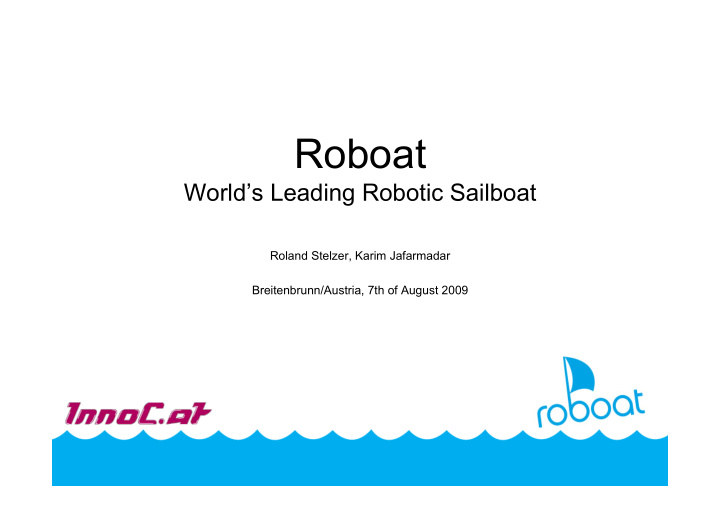



Roboat World’s Leading Robotic Sailboat Roland Stelzer, Karim Jafarmadar Breitenbrunn/Austria, 7th of August 2009
Who are we? • Since 2005 • ~ 50 members • Non-profit research organisation in Vienna • Motivation of comers for science and technology • Provide infrastructure • Network of experts 2
From Robot to Roboat www.robotchallenge.org 3
What is a robotic sailboat? Sails without any human intervention! • Weather routeing • Autonomous tacking and jibing • Emergency strategies 4
Roboat Technology Sensors Actuators • GPS • Rudder • Compass • Sails • Heel • Wind “Artificial Sailor” layered architecture 5
International Competitions • 06/2006: First Microtransat in France • 09/2007: Second Microtransat in Wales • 05/2008: World Robotic Sailing Championship in Austria • 06/2009: World Robotic Sailing Championship in Portugal www.roboticsailing.org www.microtransat.org 6
Microtransat 2006 in Toulouse/France 7
Final tests at Microtransat 2006 Toulouse – France
Microtransat 2007 in Aberystwyth/Wales 9
24h race at Microtransat 2007 Wales – Irish Sea
World Robotic Sailing Championship 2008 in Breitenbrunn/Austria Team InnoC (AUT) World Champion 1 st Team Aberystwyth (GB) 3 rd 2 nd Team MAST (CAN) 4 th Team Porto (POR) 11
World Robotic Sailing Championship 2008 Lake Neusiedl – Austria 12
World Robotic Sailing Championship 2009 in Porto/Portugal Team InnoC (AUT) World Champion 1 st Team FASt (POR) 3 rd 2 nd Team Avalon (SUI) Team Porto (POR) 13
World Robotic Sailing Championship 2009 Porto - Portugal 14
Boat characteristics Sensors • length: 3,75 m • position and speed over ground (GPS) • total displacement: 300 kg • speed through water • Sailarea : 3 m ² + 1.5 m ² • battery voltage and power consumption • self-righting design • ultrasonic wind sensor (direction and speed) • tilt-compensated compass (heading and heel) Computer • humidity, air and water temperature, air pressure, depth • Mini-ITX with Linux • 800MHz / 512MB RAM Actuators • 4 GB CF Card • sheet linear drive • Control software in Java and C++ • tiller linear actuator • automatic bilge pump Communication • horn, lights • WIFI • GPRS/UMTS Energy balance • Iridium satellite modem • 50W avg. power consumption • 1,5m ² solar panels (285Wp) • 4.6 kWh lithium ion batteries „ASV roboat“ at a Glance 15 15
Why Robotic Sailboats? • Intelligent sensor buoys • Safety on sailing yachts • CO 2 -neutral cargo transportation • Surveillance & searching • Boat as sailing trainer • Convenience on board 16
Future Challenges • The boat has to operate energetically autonomously for long time. • The boat has to detect obstacles reliably. • The boat has to avoid obstacles reliably.
Energy Balance Power Sources • Solar Panels (285 W peak, ~ 35 W avg.), unlimited • Direct Methanol Fuel Cell (65 W), duration limited to approx. 4 weeks • Power Consumption (~ 35 W avg.) • Onboard PC ~ 15 W • Sensors and further electronic • components ~ 10 W Rudder < 1 W • Sails ~ 10 W • Save Energy • Low Power PC ~ 3 W • Low Power Electronics ~ 6 W • Sails: Balanced Rig ~ 3 W • Balanced Rig Optimize Control System (can save up to 50 % • for rudder and sail actuator ) Goal: less than 15 W power consumption to have energy for further scientific equipment.
Obstacle Detection • Static obstacles (landmasses etc.) are defined in sea maps and can be considered during routing process. • Dynamic obstacles (ships, icebergs, etc.) have to be detected in real time. • Combination of different techniques, such as • Radar • Thermal imaging • Camera • Laser range scanner • Automatic Identification System (AIS)
Obstacle Avoidance Boat polar speed diagram is the basis for the short course routing system. T ... target 1 – 5 ... obstacles w ... wind t, t0 ... (unit) vector to target grey circle ... radar scan area v‘ ... optimum without obstacles v ... optimum considering obstacles r ... radius of scanner range Obstacles: 2 ... no influence because in no-go zone 5 ... no influence because out of scanner range 1, 3, 4 ... „cut“ polar 1 ... influence on route because original route through obstacle 1 obstacle detected -> modify polar diagram -> efficiency of routes towards obstacles decrease -> routing algorithm decides for alternative (navigable) routes
AAS Endurance – Marine mammal research USA Pacific Ocean Pacific Ocean Autonomous Acoustic Sailboat (AAS) Towed array behind AAS Endurance
Questions? 22
Further Information www.roboat.at – our „ASV roboat“ roland.stelzer@innoc.at – for questions Thank you for your attention! 23
Recommend
More recommend